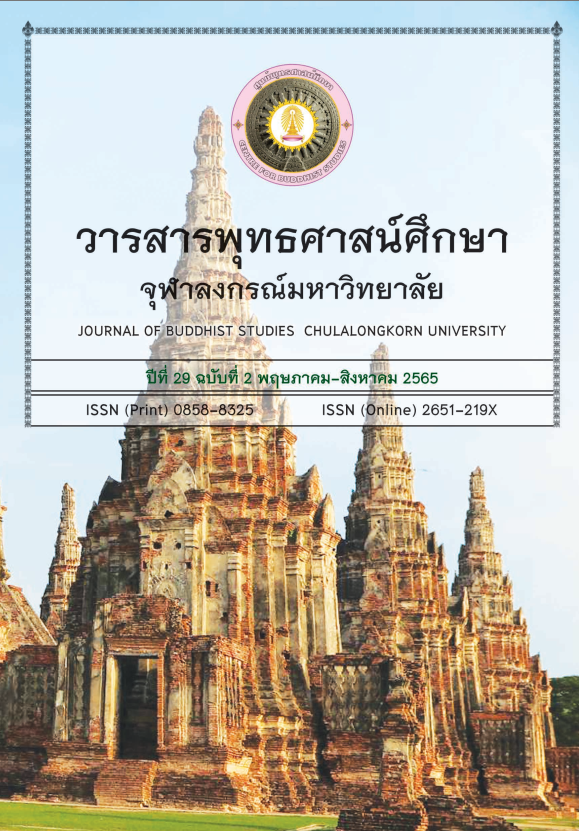Translation Problems in Prajñāpāramitāhṛdayasūtra
Keywords:
Hṛdayasūtra, Prajñāpāramitāhṛdayasūtra, svabhāvaAbstract
Prajñāpāramitāhṛdayasūtra or Hṛdayasūtra is the shortest one among the several versions of Prajñāpāramitāsūtra. In Thailand, apart from the Mahayanist monks, there are only small amount of scholars studying this sūtra, since Theravada Buddhism is predominant in Thailand. However, there are some Thai translations of this sūtra available but there is none of a comparative of this text. This paper, therefore, is an attempt to undertake a comparative study from several versions of Hṛdayasūtra i.e., Sanskrit, Chinese, Tibetan, Japanese as well as Thai translation. In this paper there are three points of discussion as follows;
1. The interpolation of some words which are available in many languages in some Thai translation, but they are not found in the original text. For instance, some Chinese-Thai translation contains a Thai word “โดยสภาพ” which is obvious that this word is borrowed and an additional to the original text.
2. The differences of the translation and interpretation among the different traditions. For example, the word śūnyatālakṣaṇā was translated into both Chinese and Tibetan languages, but in opposite meanings due to their dissimilar interpretations and traditions.
3. The different translation and interpretation of the philosophical terms in the Hṛdayasūtra. The translation and interpretation of the word svabhāvaśūnyān is the instance to be examplified in this case. Some scholars reject the others’ translation of this word as ‘(that) has the Emptiness as its own essence’, then propose their interpretation as ‘(that) is empty from its own essence’.
All in all, this paper suggests the prior conclusion that the former translation would not be wrong, if we consider the word abhāvasvabhāva as the semantic tool to support this translation and interpretation.
Downloads
References
มหาวิทยาลัยมหาจุฬาลงกรณราชวิทยาลัย. (2561). พระไตรปิฎกฉบับสากล วิถีธรรมจากพุทธปัญญา. กรุงเทพฯ: โรงพิมพ์มหาจุฬาลงกรณราชวิทยาลัย.
เลียง เสถียรสุต. (ม.ป.ป). ปรัชญาปารมิตาหฤทัยสูตร. สืบค้นจาก
https://www.facebook.com/Wat.Mangkonkamalawat.Temple/posts/685624645496489?__tn__=K-R
ส. ศิวลักษณ์. (2545). ความเข้าใจในเรื่องมหายาน (พิมพ์ครั้งที่ 2). กรุงเทพฯ: ส่องศยาม.
สุชีโว ภิกขุ. (2522). พระสูตรมหายาน: ปรชฺญาปารมิตาหฺฤทัยสูตฺรและสุขาวตีวยูหสูตร (พิมพ์ครั้งที่ 2). กรุงเทพฯ: มหามกุฏราชวิทยาลัย.
สุมาลี มหณรงค์ชัย. (2546). พระพุทธศาสนามหายาน. กรุงเทพฯ: สำนักพิมพ์ศยาม.
สุมาลี มหณรงค์ชัย. (2548). พระนาคารชุนะกับคำสอนว่าด้วยทางสายกลาง. กรุงเทพฯ: ส่องศยาม.
เสถียร โพธินันทะ. (2514). ประวัติศาสตร์พระพุทธศาสนา ฉบับมุขปาฐะ ภาค 1. กรุงเทพฯ: มหามกุฏราชวิทยาลัย.
Bühler, Georg. (1881). Palaeographical Remarks on the Horiuzi Palm-Leaf Mss. In The Ancient Palm Leaves containing the Pragñā-pāramitā-hridaya-sūtra and Ushnīsha-vigaya-dhāranī: Anecdota Oxoniensia, Aryan Series Vol.1 part 3. pp.63-95.
Conze, Edward. (1967). Thirty Years of Buddhist Studies Selected Essays. Oxford: Bruno Cassirer.
Conze, Edward. (1978). The Prajñāpāramitā Literature. 2nd ed. Tokyo: The Reiyukai (BibliographiaPhilologica Buddhica Series Major, I).
Dutt, Nalinaksha. (1934). Pañcaviṃśatisāhasrikā Prajñāpāramitā IV. London: Luzac (Calcutta Oriental Series, 28).
Fukui, Masami. (2000). 般若心経の総合的研究―歴史・社会・資料―.Tokyo: Shunjusha.
Gengintani, Fumiaki. (2016). シュリーマハージャナ般若心経義遍知. In Watanabe, Shogo., Takahashi, Hisa’o (Eds.), 般若心経注釈集成 <インド・チベット編>(pp.295-322). Chiba: Kishinshobo.
Harada, Waso. (2002). 梵文『小本・般若心経』和訳. Journal of Esoteric Buddhism 209: 17-62(L).
Harada, Waso. (2010). 般若心経成立史論.Tokyo: Daisoshuppan.
Hikata, Ryusho.(1939). 仏頂尊勝陀羅尼経諸伝の研究.密教研究 68: 34-72.
Kajiyama, Yuichi. (1980). 大乗仏典〈2〉八千頌般若経I (1). 東京:中央公論社.
Kajiyama, Yuichi.,Tanji, Teruyoshi. (1980). 大乗仏典〈3〉八千頌般若経II (2). 東京:中央公論社.
Kato, Junsho. (1985). 自性と自相. In 平川彰博士古稀記念会 (Ed.), VARIOUS PROBLEMS IN BUDDHIST THOUGHT / A Collection of Articles in Honor of Professor Akira Hirakawa's Seventieth Birthday (pp. 487-509). Tokyo: Shunjusha.
Kimura, Takayasu. (1990). Pañcaviṃśatisāhasrikā Prajñāpāramitā IV. Tokyo: Sankibo Busshorin.
Kimura, Takayasu. (1992). Pañcaviṃśatisāhasrikā Prajñāpāramitā V. Tokyo: Sankibo Busshorin.
Lopez, Jr, Donald S. (1990). The Heart Sutra Explained: Indian and Tibetan Commentaries. Delhi: Sri Satguru Publications.
Miyashita, Seiki. (1994). アビダルマにおける自性の意味: 三世実有説の再検討. Buddhist Seminar 59: 1-29(L).
Miyashita, Seiki. (1997). 有部の論書における自性の用例. Buddhist Seminar 65: 1-16(L).
Mochizuki, Kaie. (2016a). ジュニャーナミトラ般若心経解説.In Watanabe, Shogo., Takahashi, Hisa’o (Eds.),般若心経注釈集成 <インド・チベット編> (pp.143-164). Chiba: Kishinshobo.
Mochizuki, Kaie. (2016b). アティシャ般若心経解説.In Watanabe, Shogo., Takahashi,Hisa’o(Eds.),般若心経注釈集成<インド・チベット編> (pp.203-226). Chiba: Kishinshobo.
Moriyama, Seitetsu. (1978).「空性思想の形成」研究序説.仏教大学大学院研究紀要 6: 145-162.
Moriyama, Seitetsu. (1979). 自性の考察. Journal of Indian and Buddhist Studies 54: 252-255.
Müller, Max., Nanjio, Bunyiu. (1884). The Ancient Palm Leaves containing the Pragñā-pāramitā-hridaya-sūtra and Ushnīsha-vigaya-dhāranī: Anecdota Oxoniensia, Aryan Series Vol.1 part 3. Oxford: Clarendon Press.
Nakamura, Hajime., Kino, Kazuyoshi. (1988). 般若心経 金剛般若経. 東京:岩波書店.
Nattier, Jan. (1992). The Heart Sutra: a Chinese apocryphal text? Journal of the International Association of Buddhist Studies, 15 (2): 153–223.
Oyagi, Ryusho. (2016). ヴィマラミトラ般若心経広大註. In Watanabe, Shogo., Takahashi, Hisa’o (Eds.), 般若心経注釈集成<インド・チベット編>(pp.69-122). Chiba: Kishinshobo.
Tachikawa, Musashi. (1994).「自性が空である」をどう解釈するか:ツォンカパ空思想研究序説.季刊仏教 26: 164-177(R).
Takahashi, Hisa’o. (2016a). シュリーシンハ・ヴァイローチャナ真言を開示せる般若心経註. In Watanabe, Shogo., Takahashi, Hisa’o (Eds.), 般若心経注釈集成<インド・チベット編>(pp.123- 142). Chiba: Kishinshobo.
Takahashi, Hisa’o. (2016b). ヴァジュラパーニ般若心経註・義灯. In Watanabe, Shogo., Takahashi, Hisa’o (Eds.), 般若心経注釈集成 <インド・チベット編>(pp.165-202). Chiba: Kishinshobo.
Ueyama, Daishun. (1990). 敦煌仏教の研究.Kyoto: Hozokan.
Watanabe, Shogo. (1979).「般若経」におけるabhāvaの用法.Journal of Indian and Buddhist Studies 74: 121-125(L).
Watanabe, Shogo. (2016a). 総論『般若心経』の成立と註釈への展開. In Watanabe, Shogo., Takahashi, Hisa’o (Eds.), 般若心経注釈集成 <インド・チベット編>(pp.3-50). Chiba: Kishinshobo.
Watanabe, Shogo. (2016b). カマラシーラ般若心経広註.In Watanabe, Shogo.,Takahashi, Hisa’o(Eds.), 般若心経注釈集成<インド・チ ベット編> (pp.51-68). Chiba: Kishinshobo.
Watanabe, Shogo. (2016c). プラシャーストラセーナ般若心経広註. In Watanabe, Shogo., Takahashi, Hisa’o (Eds.), 般若心経注釈集成 <インド・チベット編> (pp.165-202). Chiba: Kishinshobo.
Watanabe, Shogo (2018). 総論中国・日本における『般若心経』の展開と註釈. In Watanabe, Shogo., Takahashi, Hisa’o (Eds.), 般若心経注釈 集成 <中国・日本編> (pp. 3-26). Chiba: Kishinshobo.
Wogihara, Unrai. (1990). Sphuṭārthā Abhidharmakośavyākhyā: The Work of Yaśomitra. Tokyo: Sankibo Busshorin.
Downloads
Published
How to Cite
Issue
Section
License
Copyright (c) 2022 Chulalongkorn University Centre for Buddhist Studies

This work is licensed under a Creative Commons Attribution-NonCommercial-NoDerivatives 4.0 International License.
บทความที่ได้รับการตีพิมพ์เป็นลิขสิทธิ์ของศูนย์พุทธศาสน์ จุฬาลงกรณ์มหาวิทยาลัย
ข้อความที่ปรากฏในบทความแต่ละเรื่องในวารสารวิชาการเล่มนี้เป็นความคิดเห็นส่วนตัวของผู้เขียนแต่ละท่านไม่เกี่ยวข้องกับศูนย์พุทธศาสน์ จุฬาลงกรณ์มหาวิทยาลัย และคณาจารย์ท่านอื่นๆในมหาวิทยาลัยฯ แต่อย่างใด ความรับผิดชอบองค์ประกอบทั้งหมดของบทความแต่ละเรื่องเป็นของผู้เขียนแต่ละท่าน หากมีความผิดพลาดใดๆ ผู้เขียนแต่ละท่านจะรับผิดชอบบทความของตนเองแต่ผู้เดียว






